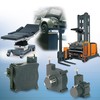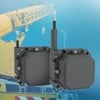Preface
The first generation of fiber-optic communication systems debuting in 1980 operated at a meager bit rate of 45 Mb/s and required signal regeneration every 10 km or so. However, by 1990 further advances in lightwave technology not only increased the bit rate to 10 Gb/s (by a factor of 200) but also allowed signal regeneration after 80 km or more. The pace of innovation in all fields of lightwave technology only quickened during the 1990s, as evident from the development and commercialization of erbium-doped fiber amplifiers, fiber Bragg gratings, and wavelength-division-multiplexed lightwave systems. By 2001, the capacity of commercial terrestrial systems exceeded 1.6 Tb/s. At the same time, the capacity of transoceanic lightwave systems installed worldwide exploded. A single transpacific system could transmit information at a bit rate of more than 1 Tb/s over a distance of 10,000 km without any signal regeneration. Such a tremendous improvement was possible only because of multiple advances in all areas of lightwave technology. Although commercial development slowed down during the economic downturn that began in 2001, it was showing some signs of recovery by the end of 2004, and lightwave technology itself has continued to grow. The primary objective of this two-volume book is to provide a comprehensive and up-to-date account of all major aspects of lightwave technology. The first volume, subtitled Components and Devices, is devoted to a multitude of silica- and semiconductor-based optical devices. The second volume, subtitled Telecommunication Systems, deals with the design of modern lightwave systems; the acronym LT1 is used to refer to the material in the first volume. The first two introductory chapters cover topics such as modulation formats and multiplexing techniques employed to form an optical bit stream. Chapters 3 through 5 consider the degradation of such an optical signal through loss, dispersion, and nonlinear effects during its transmission through optical fibers and how they affect the system performance. Chapters 6 through 8 focus on the management of the degradation caused by noise, dispersion, and fiber nonlinearity. Chapters 9 and 10 cover the engineering issues related to the design of WDM systems and optical networks. This text is intended to serve both as a textbook and a reference monograph. For this reason, the emphasis is on physical understanding, but engineering aspects are also discussed throughout the text. Each chapter also includes selected problems that can be assigned to students. The book's primary readership is likely to be graduate students, research scientists, and professional engineers working in fields related to lightwave technology. An attempt is made to include as much recent material as possible so that students are exposed to the recent advances in this exciting field. The reference section at the end of each chapter is more extensive than what is common for a typical textbook. The listing of recent research papers should be helpful to researchers using this book as a reference. At the same time, students can benefit from this feature if they are assigned problems requiring reading of the original research papers. This book may be useful in an upper-level graduate course devoted to optical communications. It can also be used in a two-semester course on optoelectronics or lightwave technology. A large number of persons have contributed to this book either directly or indirectly. It is impossible to mention all of them by name. I thank my graduate students and the students who took my course on optical communication systems and helped improve my class notes through their questions and comments. I am grateful to my colleagues at the Institute of Optics for numerous discussions and for providing a cordial and productive atmosphere. I thank, in particular, Renè Essiambre and Qiang Lin for reading several chapters and providing constructive feedback. Last, but not least, I thank my wife Anne and my daughters, Sipra, Caroline, and Claire, for their patience and encouragement. Govind P. Agrawal Rochester, NY |
Chapter 9.2.3 - Filter-Induced Signal Distortion
9.2.3 Filter-Induced Signal DistortionSo far we have considered linear crosstalk from a single device. In a realistic optical network, an optical signal may pass through many nodes before reaching its final destination, while suffering from crosstalk at each node. As a result, crosstalk can accumulate to a large level by the time signal reaches its destination. At the same time, signal may become distorted as it passes through many optical filters. In this section we address the filter-concatenation problem [35]-[37]. All filters in an optical network are designed to be wide enough to pass the signal spectrum without any distortion. However, if the signal passes through a large number of optical filters during its transmission, one must study the effects of filter concatenation. Consider a filter with the transfer function H(ω). Even when a signal passes through this filter twice, the effective filter bandwidth becomes narrower than the original value because H2(ω)is a sharper function of frequency than H(ω). A cascade of many filters may narrow the effective bandwidth enough to produce clipping of the signal spectrum. This effect is shown schematically in Figure 9.6, where transmissivity of the signal is plotted after 12 third-order Butterworth filters of 36-GHz bandwidth. Since it may be difficult to align the passband of filters precisely at all locations, the response function is also shown when filters are misaligned within the range of ±5 GHz. Clearly, the effective transfer function after 12 filters is considerably narrower and its effective bandwidth is reduced further when individual filters are misaligned even by a relatively small amount.
Figure 9.6: Transfer function of a single optical filter with 36-GHz bandwidth and changes produced by 12 cascaded filters aligned precisely or misaligned by ±5 GHz. The spectra of a 10-Gb/s signal are also shown for the RZ and NRZ formats. (After Ref. [16]; ©2003 IEEE.)
The penalty induced by cascaded filters is quantified through the extent of eye closure at the receiver. Among other things, it depends on the shape and bandwidth of the filter passband. It also depends on whether the RZ or the NRZ format is employed for the signal and is generally larger for the RZ format. As an example, Figure 9.7 shows the increase in eye-closure penalty as the number of cascaded filters increases for a 10-Gb/s RZ signal with 50% duty cycle [16]. The transfer function of all filters corresponds to a third-order Butterworth filter. Although a negligible penalty occurs when the filter bandwidth is 50 GHz, it increases rapidly as the bandwidth is reduced below 40 GHz. The penalty exceeds 4 dB when the signal passes through 30 filters with 32-GHz bandwidth.
Figure 9.7: Eye-closure penalty as a function of the number of filters for a 10-Gb/s RZ signal with 50% duty cycle. The bandwidth of filters is varied in the range of 32 to 50 GHz. (After Ref. [16]; ©2003 IEEE.) |
 TABLE OF CONTENTS
TABLE OF CONTENTS 









